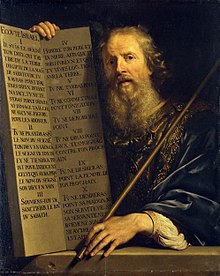Below, translated excerpts from the first chapter of Karlheinz
Deschner’s Kriminalgeschichte des Christentums
(“Criminal History of Christianity”):
Moses and the book of Judges
But not even this was enough for Moses, a character that a tract of 1598, On the Three Great Liars, blamed for “the largest and most egregious crimes” (summa et gravissime Mosis crimina) insofar as when “angry with the commanders of the army” he asked how they had spared the women and children. “Therefore kill all those men, even the children, and cut the throat of the women that have known a man; keep only girls and all the maids… And it was found that the booty was taken by the army of six hundred and seventy-five thousand sheep, seventy-two thousand oxen, donkeys, seventy-one thousand, and thirty-two thousand female virgins”—tremendous killings and robberies that also were contrary to the fifth and seventh commandments by Moses himself.
In a word, they perpetrated the most horrible atrocities and praise themselves for it, and burned towns and villages to leave no stone unturned. Today, when excavating the ancient Canaanites doublings, it is common to find a thick layer of ash that confirms the destruction by fire. One of the most important Palestinian cities in late Chalcolithic, Tell-Isdud or Ashdod, located in the international route of the sea (via maris) and that would become the capital of the Philistine Pentapolis, disappeared, destroyed by fire in the thirteenth century B.C., like its neighbor Tell-Mor.
Sometimes exterminating whole tribes spread because it was common to throw at the enemy the most severe form of war decreed by the Lord, the accursed (Hebrew herám, which was the negation of life itself, and which root derives from a word meaning “sacred” to the Western Semites): something offered to Yahweh as a kind of vast hecatomb or “ritual sacrifice.” Not by chance the biblical descriptions of “settlement” have been compared with the later campaigns of Islam (not nearly as bloody as those), when it is said that the conquerors should truly feel “custodians of the word of God” and protagonists of a holy war. “Just these, not the profane wars, end the anathema which means the extermination of all living in the name of Yahweh” (Gamm). Precisely, the “destruction at the roots can only be explained by the religious fanaticism of the Israelites.”
Those are the cases where the Lord expressly commands: “For in the towns that you shall not leave a living soul, but without differentiation you shall kill by the sword, namely: the Hittites and the Alamorreo, and the Canaanites and the Perizzites, and the Hivites, and the Jebusites, as the Lord your God has commanded you, lest they teach you to make all the abominations that they have used with their gods, and offend your Lord.”
Such excesses of faith had their origin, in the first place, in nationalism of that ancient people, undoubtedly one of the most extremist ever known, combined with the rigor of a monotheism unknown in those regions. Both elements mutually potentiated the claim to be the chosen people.
The Israelites of the pre-Davidic time committed the most terrible crimes, and celebrated the genocide as a pleasing action to the Lord’s eyes, almost as a symbol of faith. And that “holy war,” then and later was carried out with particular vehemence, without admitting negotiations or agreements. Only the extermination of the enemy, the uncircumcised (or unbaptized, the “heretic,” the “infidel”) is “a typically Israelite trait” (Ringgren).
In most respects, the description of the Old Testament book of Judges, dated between 1200 and 1050, i.e., a century and a half after the “settlement,” is a source of information if not entirely reliable, quite valid, and it barely mentions anything but “holy wars.” These always began with blessings, after a period of sexual continence, and usually ended with the total liquidation of the enemy: men, women and children. “The ruins of many villages and towns, repeatedly destroyed during the twelfth and eleventh centuries, provided the most graphic of archaeological commentaries” (Cornfeld / Botterweck).
The Ark of the Covenant, assurance of God’s presence, accompanied the massacres.
